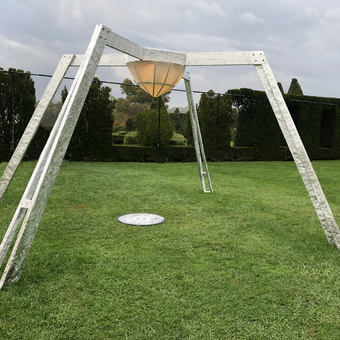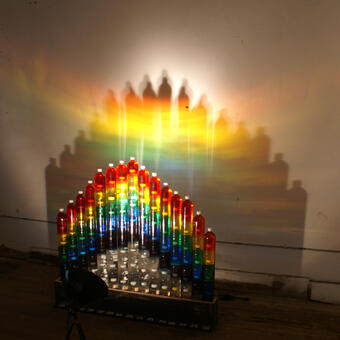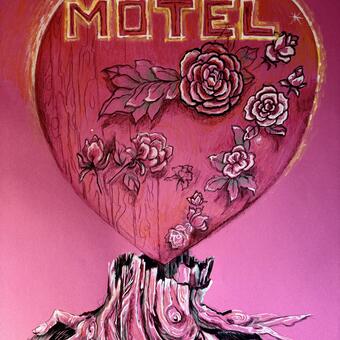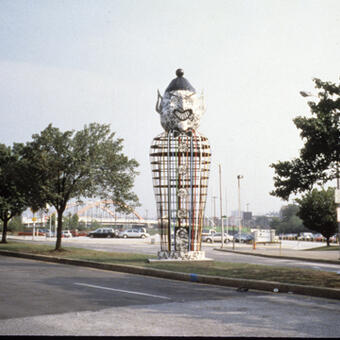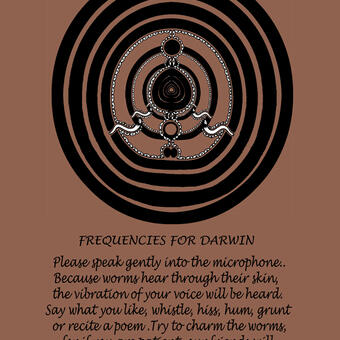Work samples
-
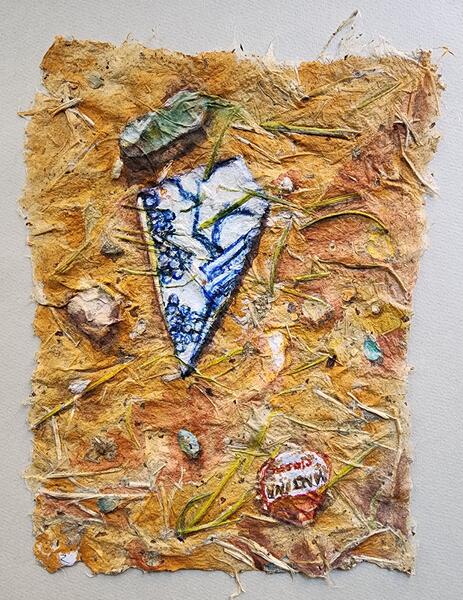 A lot of moments, a lot of stories
A lot of moments, a lot of storiesThis painting is part of a series of work begun in 2023, Vacant Lots Are Full of Stories, based on objects found in one or more so-called vacant lots near my studio. It was created using watercolor and gouache on paper made from white mulberry bark, a "weed tree" that is considered to be an invasive species on this continent. Tiny bits of a torn letter were added to the vat, prior to pulling the paper, and some of the text, or marks, on the paper are visible. The painting is small, of an intimate size, 8" H x 6" W, unframed.
The images are of objects found in a block long lot, where a row of houses stood for almost 100 years: a fragment of "Blue Willow" pattern china, a rusty bottle cap (most likely from a Mexican soda), rocks and pebbles. For decades, these houses contained families that lived, worked and played in and around what is now a "vacant" lot. The houses were all razed to make room for.....something....nothing has materialized but the remnants of those lives continue to rise to the surface. I cannot help but think that most passersby would assume that the people who lived in those houses were "impoverished" in many ways, The beauty of this shard of pottery, and of others that I have found, indicates otherwise.
Available for PurchaseContact by email to: [email protected]
-
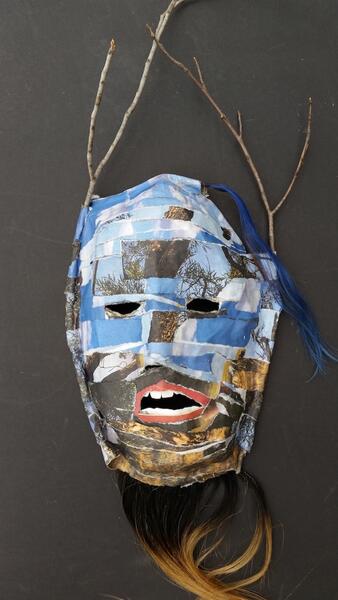 We Need the Trees to Breathe
We Need the Trees to BreatheThis mask represents a tree spirit that is trying to breathe. We need the trees to breathe in order for us to breathe clean air.
The part that would cover the face is 10.5" x 7" x 4" and the hair and twig extensions increase the dimensions to 25" x 7" x 4". It was completed in 2017.
A year or more earlier, as a fundraiser for an art event in Wyman Park Dell, I had made several simple masks using the aluminum top of a carryout container as a base for the paper mâché. Eyes were cut out and a slit was made for the nose and mouth. In making this one, I used a paper plate to make the triangular nose shape, to bring out the form from the plane of the face. The outer edge of the paper plate was used to give the impression of teeth, covered by the slightly parted lips of the mouth. Pages from the New York Times Sunday newspaper were used to make the paper mâché with archival glue. Images were selected that showed trees, sky, and water — on the reverse, or the side that would not be seen when worn, images of people were included.
Hair extensions, found on the street, washed, combed and dried were attached to the top of one side of the face and to the "chin". Twigs were used to roll the paper mâché on the sides and extend above the head.
There is a degree to which this mask "made itself". As I began to cover the basic mask with full-color images from the newspaper, trees and sky began to come into focus and the mouth took on the form of a being trying to breathe. On my walks to work each weekday, I often found cast off hair-extensions, some brightly colored. The two that I used for this mask seemed perfect to bring it to life as a tree spirit.
Available for PurchaseContact by email at: [email protected]
-
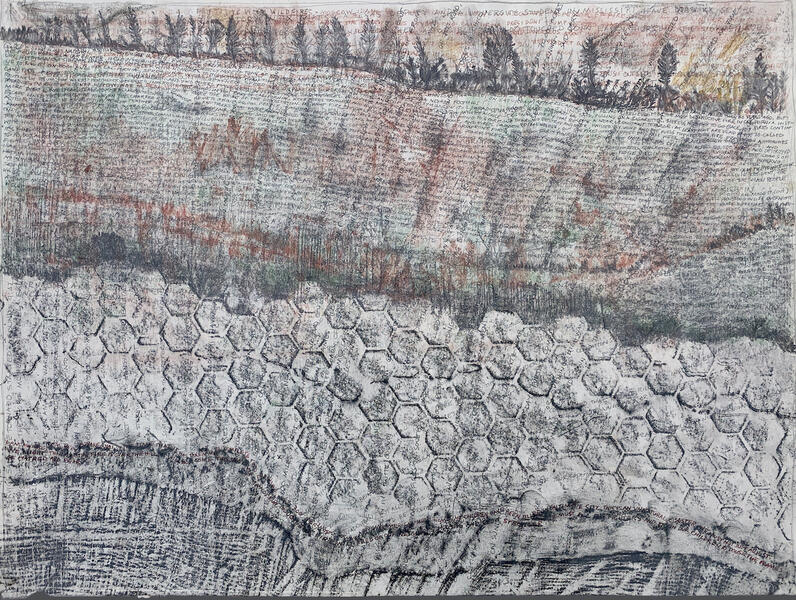 We will teach our children to fight the flames
We will teach our children to fight the flamesThis drawing, 17,5" x 23", was completed in 2019 shortly after the wild fire, known as the Camp Fire, that destroyed the town of Paradise, CA and over 150,000 acres in the surrounding area. That was 2018, many wild fires have followed with a staggering loss of life: human, animal and vegetable, including acres of mature trees and the habitat that they created.
The bottom quarter of this drawing is a graphite rubbing of the stump of a tree that was at least one hundred years old and had lived, and slowly died, across the street from a studio that I had. It was such a beautiful tree that I made as many rubbings of the trunk, as a memorial, as I could. The circle of bark can be seen at the top of that section.
Above the tree rubbing, after reports of the Camp Fire began to come out, I made rubbings of some of the textures that might be found in a house like one lost in that and other wild fires: a bathroom floor, the wood grain of a door and tongue and groove floor boards.
From the top of the page to the rubbing of the bathroom floor, I wrote words from some of the news reports of the fires and added text from reports of incidents of hatred: racist attacks, anti-semitic graffiti, homophobic slurs — sadly, those are just a few examples. Layered over the written text are graphite pencil drawings of bushes in the middle ground and trees along ridges in the background, conte crayon was added to indicate the red smoke that is in the wind. The fires are coming over the ridge, seemingly in the far distance, but threatening to grow in intensity.
The title refers also to fires of hatred, prejudice, ignorance and injustice, among others, that I feel we can and must teach our children to douse. This drawing was selected for inclusion in the 31st National Drawing and Print Exhibition and was chosen by the juror, Doreen Bolger, for a Purchase Prize Award. It is in the permanent collection of the Gormley Gallery at Notre Dame of Maryland University.
-
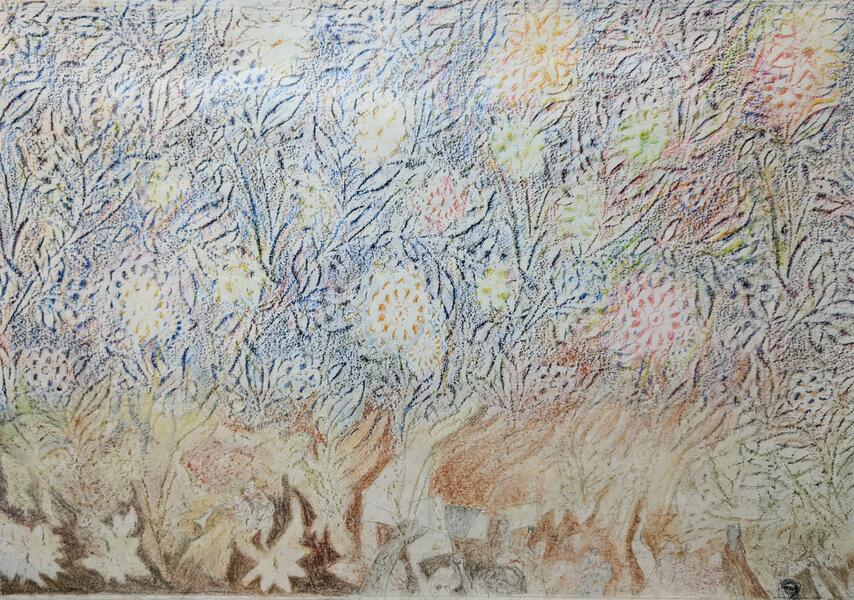 There were fireworks every night and the sparks fell to earth like flowers
There were fireworks every night and the sparks fell to earth like flowersThis drawing was made following the deaths, first, of Freddie Gray then George Floyd — then far too many others, some of whom died before George Floyd but whose deaths remained obscure until they were brought to light by the "Black Lives Matter" and other activists. In Baltimore, in 2020, fireworks were set off almost every night in the area around my studio and continued throughout the summer into the fall. Protestors continued to show up across the United States, fires were set, buildings burned, curfews put in place. The sound of fireworks were difficult to tell apart from gunfire but the light illuminated the night and I hoped that each spark would somehow spark healing. Embedded in the drawing are the names of the 2020 Valedictorians and Salutatorians of Baltimore City high schools; due to the Covid pandemic, City high schools did not hold in-person graduations that year.
I used woodless colored pencils to make rubbings of a pressed tin wall covering from a Baltimore row house apartment. The simple flower-like forms made me think of fireworks. Those rubbings continue from the top and become less detailed and fainter at the bottom of the drawing, merging into images of people protesting, some carrying signs. The drawing is 29" x 39", framed, and was created in 2020. It was framed by Full Circle Framing and Gallery.
Available for PurchaseContact by email: [email protected]
About Annette
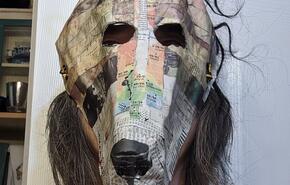
The work in this portfolio reflects a long-time interest in palimpsests, the layering of text and images over other, older texts and images. As an artist with a life-long, serious hearing impairment, palimpsests are used as a visual representation of hearing loss: text is hidden within the drawing, appearing and disappearing under various conditions.
Recent work includes paintings on paper, made from “weed” trees and plants, of objects found in “vacant” lots in Baltimore City — lots… more
Vacant lots are full of stories
This is a series of small, 8" x 6", thus intimate, paintings of objects found in vacant lots around my studio. The paintings were made with watercolor and gouache, on paper made from white mulberry bark — a "weed tree" that is considered to be an invasive species on this continent. A lot of the texture of the mulberry fiber was left in the paper, to give the feeling of a plot of dirt and weeds. Additional detail is provided under each painting.
-
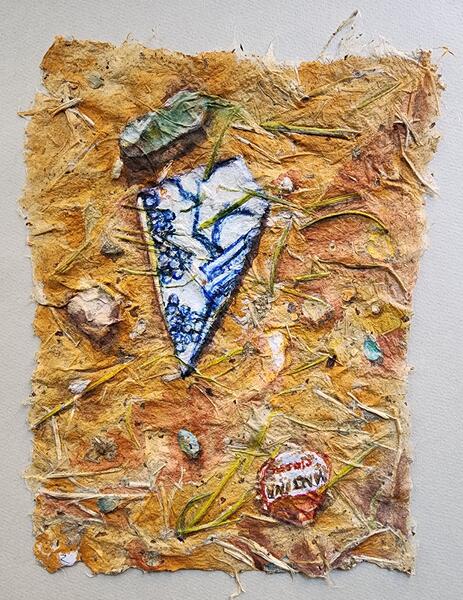 A lot of moments, a lot of stories
A lot of moments, a lot of storiesThis small painting, 8" x 6", was made with watercolor (commercially made using natural, hand-ground pigments, and beeswax as the vehicle) and gouache, on paper made from the inner bark of a white mulberry tree. The white mulberry was imported to this continent to create a silk industry in the 18th century and has spread widely; it is considered to be an invasive species. The subject matter is of objects found in a so-called "vacant" lot behind my studio in Baltimore City.
The shard of china shows a "Blue Willow"- like pattern painted on the white underglaze. My father's mother was Filipino and, though my father denied his Asian heritage * he often told the story of "The Blue Willow". A note that was torn into small pieces was added to the vat before pulling the paper and those pieces are visible as white marks, some with parts of letters visible.
*it was illegal, in the US, for my grandparents to be married and they and all of their five oldest children lived in the Philippines prior to the start of World War I. They moved to San Francisco in 1918, where my father was born.
-
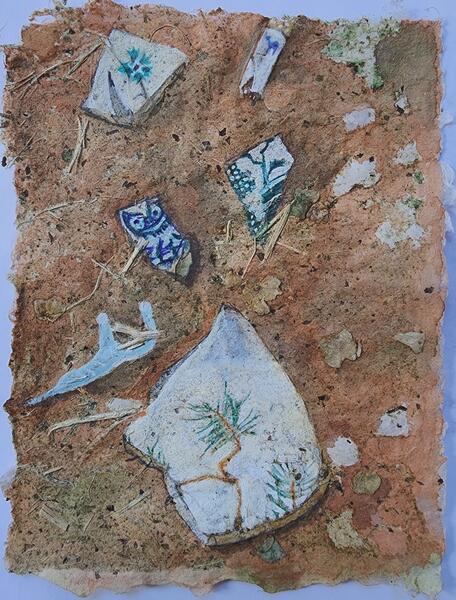 Vacant lots in Baltimore tell lots of stories
Vacant lots in Baltimore tell lots of storiesThis painting is of objects found in a lot that, for around 100 years, contained a block of houses that, in turn, contained families and individuals who lived worked and played on this ground for generations. Included with the shards of beautiful china, which is an indication of the beauty of some of the objects in these homes, there is a more recent artifact — the ubiquitous, discarded tooth flosser.
Available for PurchaseContact by email to: [email protected]
-
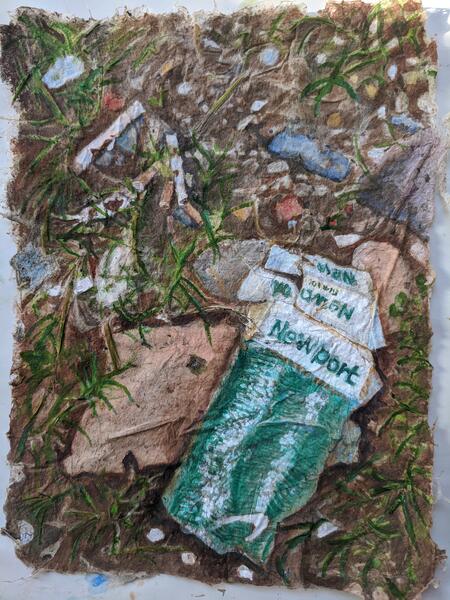 Pack of Newports # 2
Pack of Newports # 2One rainy Fourth of July night, as I was walking to a neighbors' house, I saw of a pack of Newport cigarettes with several whole, unsmoked but crushed, cigarettes nearby — I can imagine the....disappointment? frustration? anger?.... of the smoker as those costly cigs fell into the muddy field. It seems like a portrait of a small tragedy.
I am not a smoker, not that I didn't try when I was in college. Therefore, I do not fully understand the popularity and ubiquity of Newport cigarettes in Baltimore. Nor do I understand the tendency to just drop the empty pack or empty carton on the street when the contents have been consumed. Empty Newport packs are almost everywhere in Baltimore and, seemingly, especially in the neighborhoods around my studio. I can follow them like a trail of breadcrumbs to get home again.
Available for PurchaseContact via email address: [email protected]
-
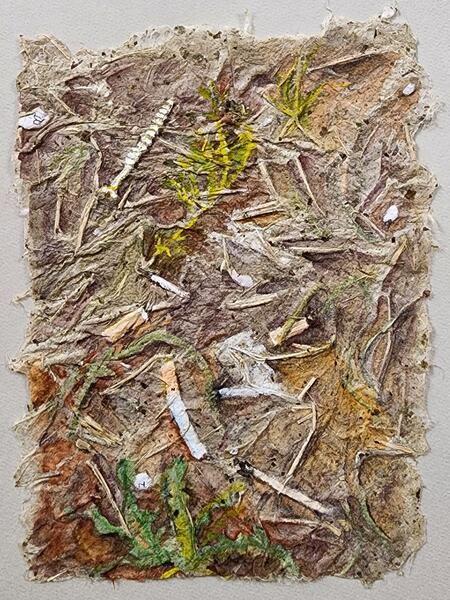 A lot of stories; a loosie, two butts, some matchsticks and a lost screw
A lot of stories; a loosie, two butts, some matchsticks and a lost screwRecently, I have accepted the responsibility to clean the two-block area around my studio and I go out on alternate Sundays to pick up trash. I don't usually keep the things that I pick up (!), often I take a photo if I have a chance but, even when I get frustrated by the amount of trash that is left on the street and sidewalks, I treasure some of the still-lives that I find in this wonderful city.
This small watercolor painting is based on a photograph that I took on one of those days, of objects found in a small plot of land, next to a corner grocery store, in Baltimore City: a full-sized, unsmoked, cigarette (a "loosie"), two partially smoked "butts", with matchsticks that might have been used to light those, and a perfectly good, brand-new, screw that was dropped in the lot and lost. I am very interested in the ways in which those objects tell stories of the people who live in this neighborhood and shop at that corner store.
The 2024 painting is small, 8" H x 6" W, unframed. It is currently in a show, GRIT, at XoXo Gallery, in the Maryland Art Place building.
Available for PurchaseContact via email: [email protected]
-
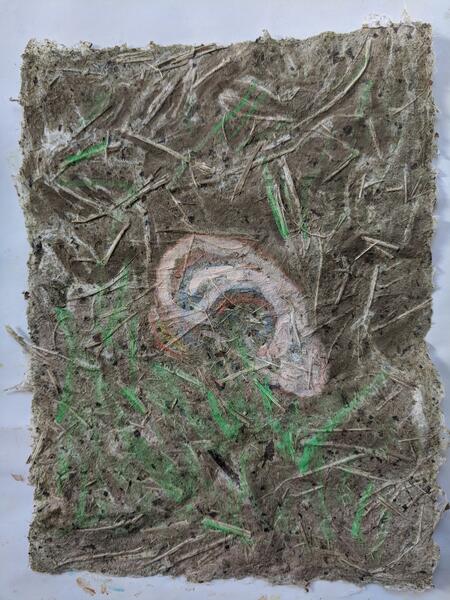 Severed Ear # 2, vacant lots are full of stories
Severed Ear # 2, vacant lots are full of storiesI made a similar painting in or around 2023 as an homage to David Lynch's Blue Velvet and as a gift for a friend. This version was made at the request of the owner of Galactic Panther Gallery for a late 2023 exhibition. The idea of finding a severed ear (Blue Velvet? Van Gogh? the Japanese ghost story of Hoichi the Earless?) is horrifying and mystifying. After Hoichi the Earless' ears were pulled off by the ghost, what happened to those ears?
Available for PurchaseContact by email to: [email protected]
-
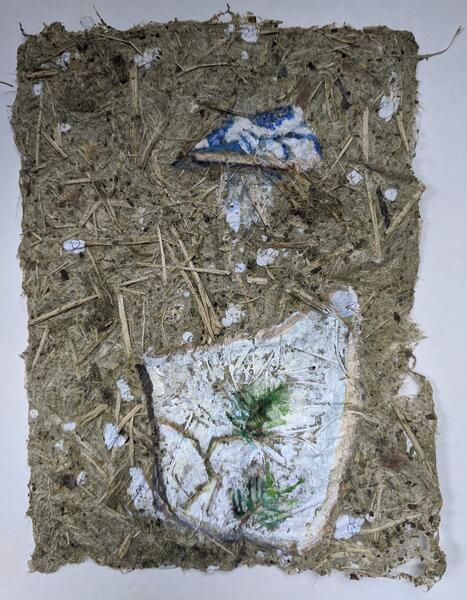 Vacant lots are full of stories- Brentwood Avenue
Vacant lots are full of stories- Brentwood AvenueThis small, 8" x 6", painting is the first in a series that features a beautiful shard of china decorated with a coniferous tree branch and needles. I found the shard in the fenced backyard behind my studio and I believe that the neighborhood rats dug it up and deposited it there. Maybe they were hoping to decorate their burrows with it? The other small shard, with the Blue Willow-like pattern, is paired with the pine tree shard in several paintings made after this one. All of those paintings are now in private collections in New York City.
-
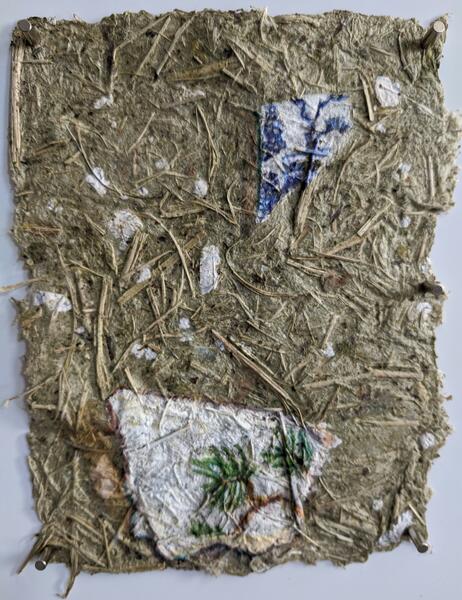 Vacant lots are full of stories- Brentwood Avenue # 2
Vacant lots are full of stories- Brentwood Avenue # 2This painting is second version of the painting called "Vacant lots are full of stories — Brentwood Avenue". Each are in the collection of artists in New York City.
-
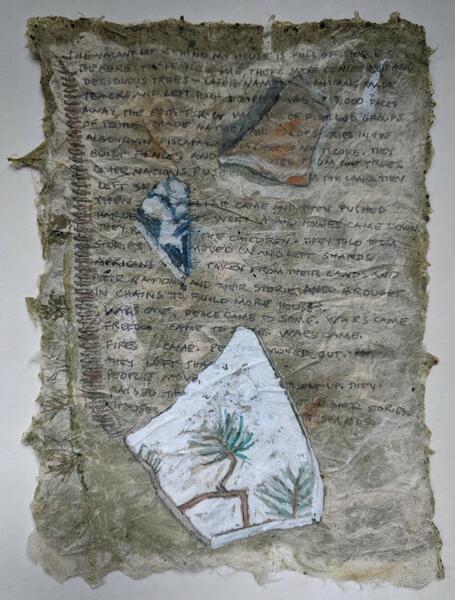 Vacant lots are full of memories
Vacant lots are full of memoriesThis small, 8.5" x 6", watercolor and gouache painting is on paper made from white mulberry tree and, as a technical note, was "couched" together with a sheet of paper that I made with Japanese kozo fiber — another kind of mulberry fiber. The "invasive" white mulberry tree was brought to this country from Asia, in an effort to create a silk industry and has proven to be a hardy and opportunistic species.
It is my understanding that The Blue Willow pattern was also brought to this country, from Asia, through Europe. My father, who denied his Asian heritage, couldn't help but tell his children the story of the Blue Willow lovers whenever the china was used.
In this painting, I have included a drawing of a stockade fence that separates the backyards of houses that surround the "vacant" lot behind my studio. Those fences are very similar — though much smaller— to the fences that were built by the Piscataway who may not have lived on this land but probably hunted and fished nearby. The written text in the background is a reflection on some of those stories.
In addition to the shards of beautiful, fine china there is a painting of another shard that I found, it is much more humble but probably much older. It speaks to the history that pre-dates the houses that existed on this lot for nearly one hundred years.
-
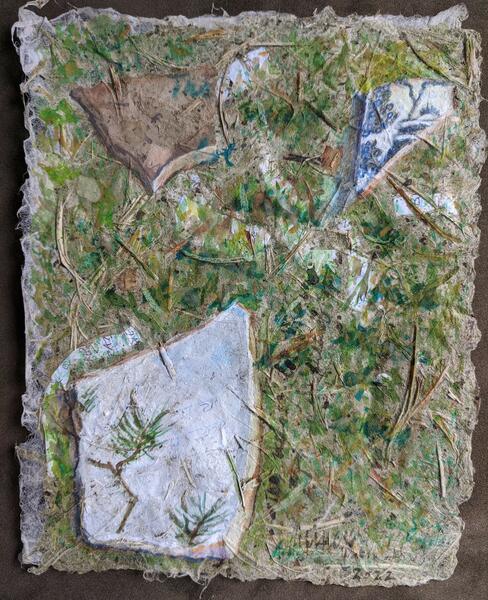 Vacant lots are full of stories and deafness is full of sounds.
Vacant lots are full of stories and deafness is full of sounds.This painting is as much about the idea that "vacant lots" are full of stories as it is about the fact that deafness is rarely, if ever, silent. The images are similar to those in the other paintings in this series but the written text is more dominant — though the words cannot easily be deciphered.
This painting is in a private collection in the Washington, DC area.
-
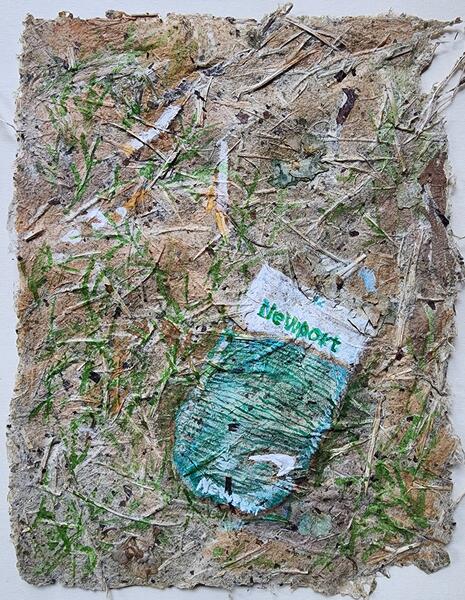 Pack of Newports # 3
Pack of Newports # 3The photograph of this painting does not show the color accurately. I will plan to get a better shot. I was pleased with the transparency of the paint, showing the pack of Newports and cigarette butts seeming to disappear into the grass and weeds.
Available for PurchaseContact by email to: [email protected]
Visual Anaolgies of Hearing Impairment
The work in this series is all based on attempts to create visual analogies of hearing impairment: the missed sounds, partial words, misunderstood speech and misinterpretations of what is heard. The titles of some of the drawings are taken from an audiology research paper, which I found online after I had already begun creating "visual analogies of hearing impairment". Much to my surprise, that was the exact title of the paper.
The earliest work, from around 2000, incorporates American Sign Language (ASL) "finger-spelling", images from speech-language pathology texts and audiology materials. Later work, created between 2011- 2017, are palimpsests: layers of text that was erased and over-written with images added over the smudgy surface.
As noted in my bio, I have a significant, life-long, hearing impairment that went undiagnosed for almost three decades — despite the fact that both of my younger brothers, my father, several of his siblings and his father all had impaired hearing. Unfortunately, once I was diagnosed, I was prescribed only one aid and it took another two decades to get a second and an additional eight years before I was qualified for and was provided with two, free, matched, digital aids. I vowed to never go back.
-
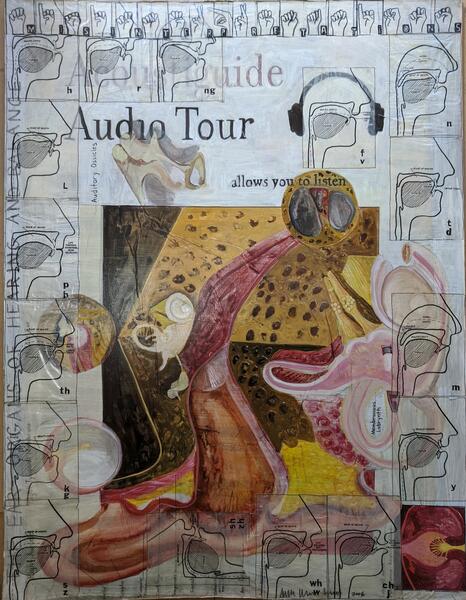 MISINTERPRETATIONS- Audio Tour, Acoustic Guide
MISINTERPRETATIONS- Audio Tour, Acoustic GuideThis 37.5" x 27" painting with collage, was created in 2005 after another artist gave me a discarded museum board that had instructions for an "Audio Tour" of an exhibition at a major museum. The watercolor painting and black and white collage elements were made on vellum, allowing some of the text of the "Audio Tour" board to be visible.
The main, watercolor, image was taken from an anatomy poster sold for displayed in audiologists' offices and medical school classrooms. The black and white collaged images were copied from a speech-language pathology textbook and American Sign Language (ASL) "finger-spelling" is across the top, spelling "MISINTERPRETATIONS".
I had learned finger-spelling as a child, thinking that I would "teach the deaf" when I was an adult. The awareness of my own hearing loss was over a decade away. Since then, I have learned some basic ASL signs, as well as improving my finger-spelling, and hope to be able to learn more ASL in the near future.
Available for PurchaseContact by email: [email protected]
-
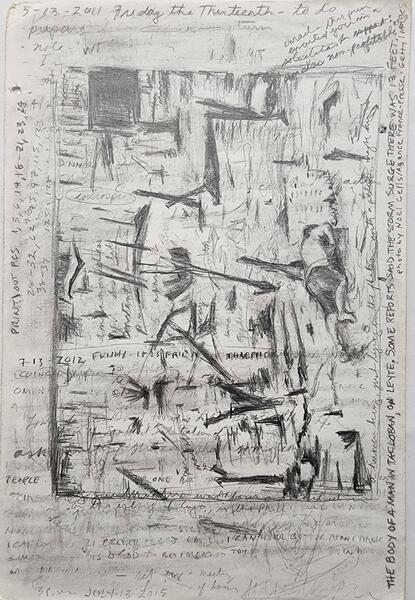 Tacloban Philippines, thirteen feet, 2013
Tacloban Philippines, thirteen feet, 2013This drawing was done following Typhoon Haiyan, which struck the Philippines in 2013. It is a palimpsest of telephone messages that were taken over several years — with some anxiety, due to a life long severe hearing loss — relayed, erased and rewritten.
My grandmother was Filipino, though my siblings and I were always told that she was Spanish. My grandparents married in the Philippines, where they raised the first five of their children, moving to San Francisco around 1919, when my father was born. It was illegal for them to be married in the United States until around that time. Until 1967, it was illegal in the state in which I was raised for my parents to be married.
One of my cousins has re-connected our family with those who still live in the Philippines and others who have immigrated to the U.S. It has been painful, over the years, to watch news of those islands but, for now, conditions are improving for many.
Available for PurchaseContact by email: [email protected]
-
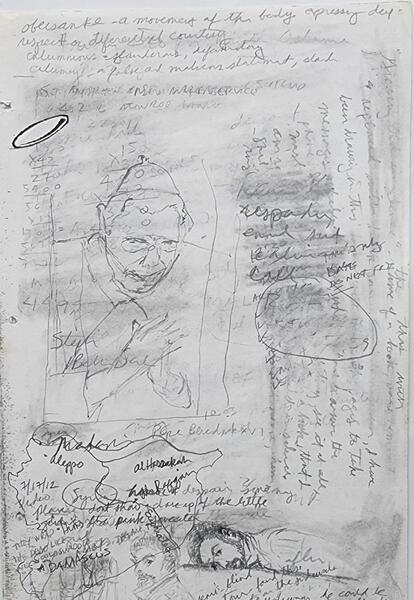 Visual Analogies of Hearing Impairment — Obeisance
Visual Analogies of Hearing Impairment — ObeisanceThis small graphite drawing, 8.5" x 5.5", was created over several years. It is a palimpsest. I had a government job for which one of my responsibilities was to take phone messages and relay those to the intended recipient. Initially, I was provided with some #2 pencils that must have been in storage for quite a while because the erasers had become dry, hard and unusable as erasers. I would write down a phone message, relay it, erase the message (which only smeared the graphite with the old erasers) and overwrite it with the next message. After a surface of text and tones was created, I would make a drawing based on images from the news.
The images in this palimpsest are: Pope Benedict, a man in Aleppo, a map of Syria, and a drawing from a photograph of a man that I found on the street. Text from news reports of the impact of the war in Syria on the people who lived there was added.
Available for PurchaseContact by email: [email protected]
-
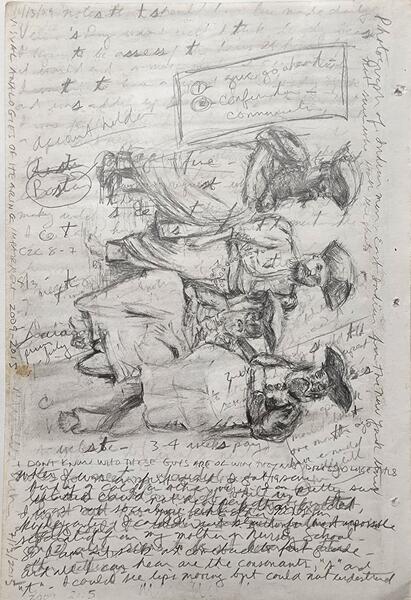 Visual analogies of hearing impairment — Degraded Grouping
Visual analogies of hearing impairment — Degraded GroupingThis small graphite drawing, 8.5" x 5.5", was created over several years and is a palimpsest of text and images. I had a government job for which one of my responsibilities was to take phone messages and relay those to the intended recipient. Initially, I was provided with some #2 pencils that must have been in storage for quite a while because the erasers had become dry, hard and unusable as erasers. I would write down a phone message, relay it, erase the message (smearing the graphite with the old erasers) and overwrite it with the next message. After a surface of text and tones was created, I would make a drawing based on images from the news.
The title of this piece, "Degraded Grouping", does not refer to the group of men! It was taken from a section of an audiology research paper that I found when searching for "visual analogies of hearing impairment". I had been referring to these drawings as "visual analogies of hearing impairment" for quite a while and was very surprised to find there was a paper with that exact title.
Available for PurchaseContact by email to: [email protected]
-
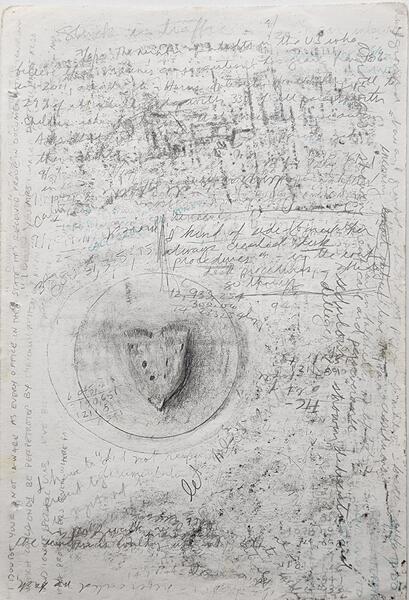 Perceptual Interference in Everyday Settings
Perceptual Interference in Everyday SettingsLike the others in this series, this is a small graphite drawing, 8.5" x 5.5", which was created over several years and is a palimpsest of text and images. The text is made up of phone messages and other notes that I had to relay as part of an office job. The image is of a dead moth that I found on my desk one morning. The title of this piece, Perceptual interference in Everyday Settings is from an audiology research paper, which was titled Visual Analogies of Hearing Impairment. I have not, since, been able to find that paper online.
One of my main responsibilities at that job was to write down phone messages and relay them to the intended recipient. Initially, the only tools that I had, with which to take messages, were some old #2 pencils — with hardened erasers that smeared the words when used — and copier paper. I had a small sketchbook which a Baltimore artist had upcycled from a text book, "Growing Old in Silence" and I used that to write down the messages, erasing and overwriting with new messages as I received them.
Available for PurchaseContact by email to: [email protected]
-
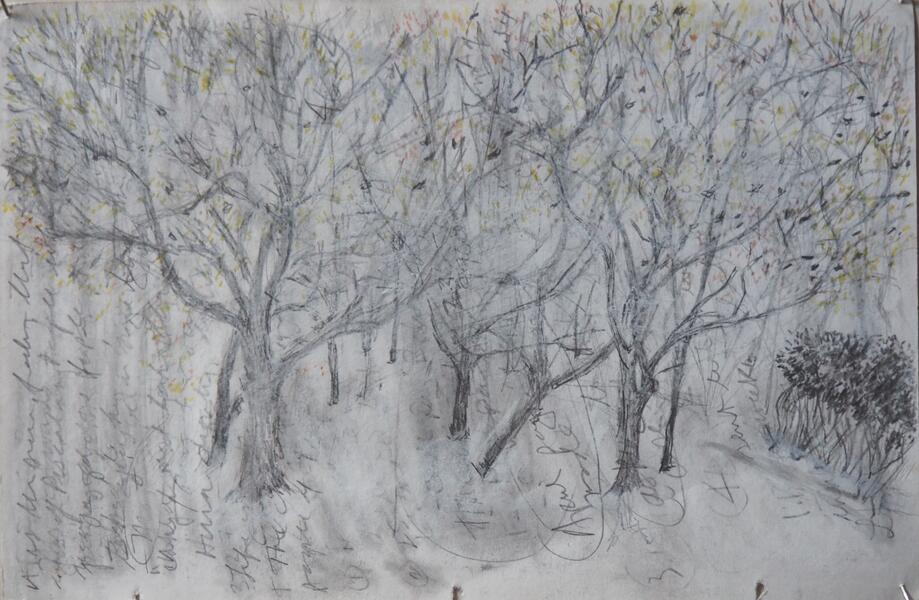 The Trees Hold Our Stories
The Trees Hold Our StoriesThis drawing is of a small group of trees at the edge of a park that is bordered by several heavily trafficked streets. I imagine that the trees could tell us a lot of stories if we could only understand their language. The drawing is layered over written text from phone messages and other notes. Colored pencil was used to add small bits of red and orange to the tops of the trees.
Available for PurchaseContact by email to: [email protected]
-
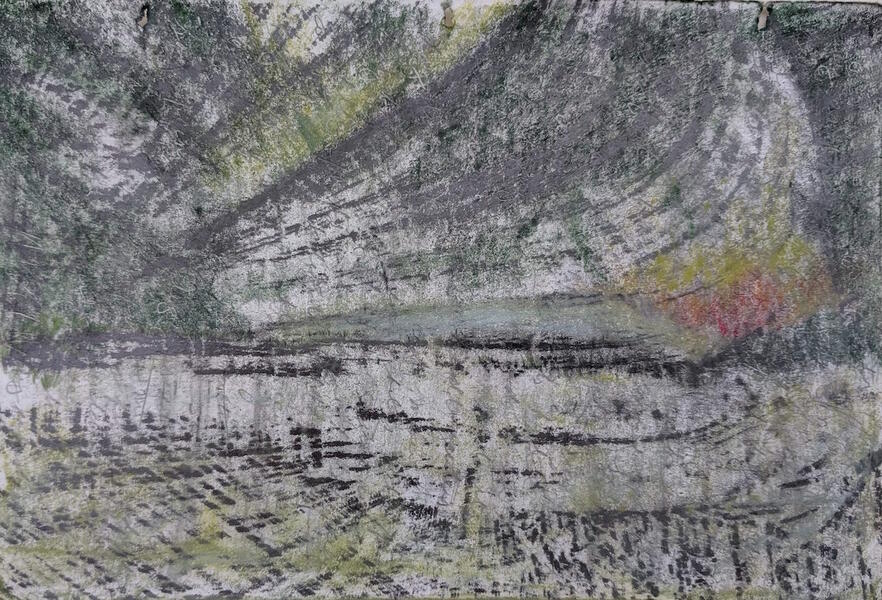 Aural Borealis
Aural BorealisA rubbing of an ancient tree, which was slowly dying in a Baltimore City park, was made over the written texts of office phone messages taken over several years and erased. The rubbing and text created an image that appeared to be a landscape with water and churning clouds and was then overlaid with pastel to evoke an image of an aurora borealis.
Masks
Paper mâché masks made from newspapers, hair extensions and, in some cases, twigs from trees.
-
 We Need the Trees to Breathe
We Need the Trees to BreatheThis mask represents a tree spirit that is trying to breathe. We need the trees to breathe in order for us to breathe clean air.
The part that would cover the face is 10.5" x 7" x 4" and the hair and twig extensions increase the dimensions to 25" x 7" x 4". It was completed in 2017.
A year or more earlier, as a fundraiser for an art event in Wyman Park Dell, I had made several simple masks using the aluminum top of a carryout container as a base for the paper mâché. Eyes were cut out and a slit was made for the nose and mouth. In making this one, I used a paper plate to make the triangular nose shape, to bring out the form from the plane of the face. The outer edge of the paper plate was used to give the impression of teeth, covered by the slightly parted lips of the mouth. Pages from the New York Times Sunday newspaper were used to make the paper mâché with archival glue. Images were selected that showed trees, sky, and water — on the reverse, or the side that would not be seen when worn, images of people were included.
Hair extensions, found on the street, washed, combed and dried were attached to the top of one side of the face and to the "chin". Twigs were used to roll the paper mâché on the sides and extend above the head.
There is a degree to which this mask "made itself". As I began to cover the basic mask with full-color images from the newspaper, trees and sky began to come into focus and the mouth took on the form of a being trying to breathe. On my walks to work each weekday, I often found cast off hair-extensions, some brightly colored. The two that I used for this mask seemed perfect to bring it to life as a tree spirit.
Available for PurchaseContact by email at: [email protected]
-
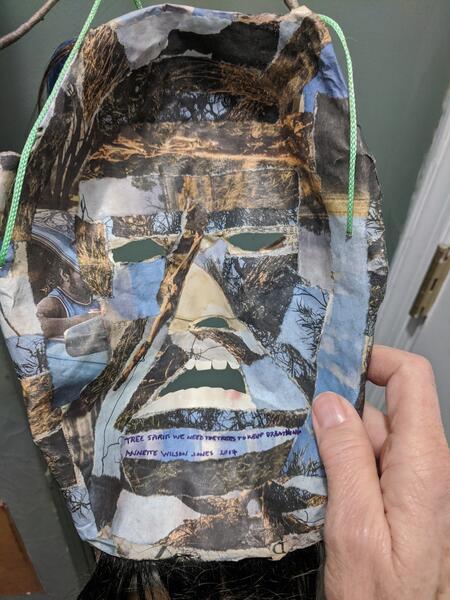 We Need the Trees to Breathe- reverse side
We Need the Trees to Breathe- reverse sideThis is the reverse side of the mask, the side that would be hidden when worn.
Available for PurchaseContact by email: [email protected]
-
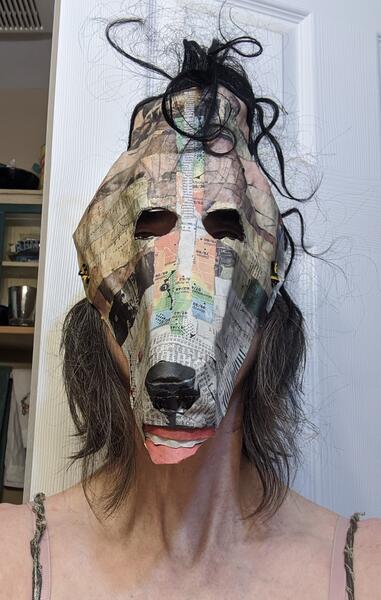 The Wolf Is At the Door— but it just wants us to listen
The Wolf Is At the Door— but it just wants us to listenThis title of and images used in the making of this mask refer to changes in weather and environment. We need to pay attention and respond before it's too late.
Like others, this mask was made of paper mâché, but uses weather maps and published weather predictions rather than images from newspapers. Rather than use a carryout container lid as the form for the paper mâché, an animal skull was used as the base. Plastic was laid over the skull and the base layer of paper mâché was removed when dry.
Hair extensions, found on a sidewalk in Baltimore — washed, combed and dried — were added to the top of the skull. Red paper was used for the lips and tongue and black paper was used to create a nose with nostrils.
-
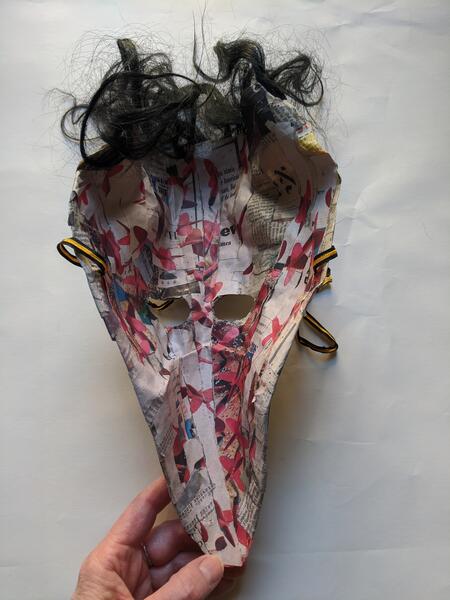 The Wolf Is At the Door- but it just wants us to listen (reverse side)
The Wolf Is At the Door- but it just wants us to listen (reverse side)This is the reverse of the mask with the same name. It shows the side that would not be seen when the mask is worn and the ties that are used to hold the mask in place.
-
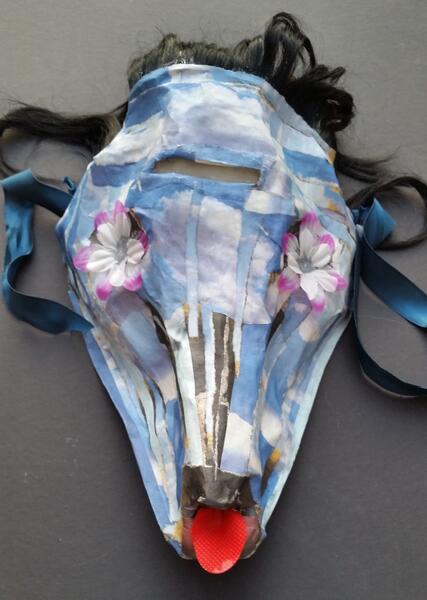 The Dead may be disguised, approach all with respect and a sense of humor
The Dead may be disguised, approach all with respect and a sense of humorThis paper mâché mask represents someone or something that has "passed on" from this plane of existence (as it said of the dead) and is intended as a reminder that the Dead may walk among us, so treat all with respect— and a sense of humor because they might dress funny.
It was made using an animal skull as the base shape; the skull was removed as the paper dried. A tongue was added, as if the Being was "blowing a raspberry" or sticking its tongue out at the viewer.
-
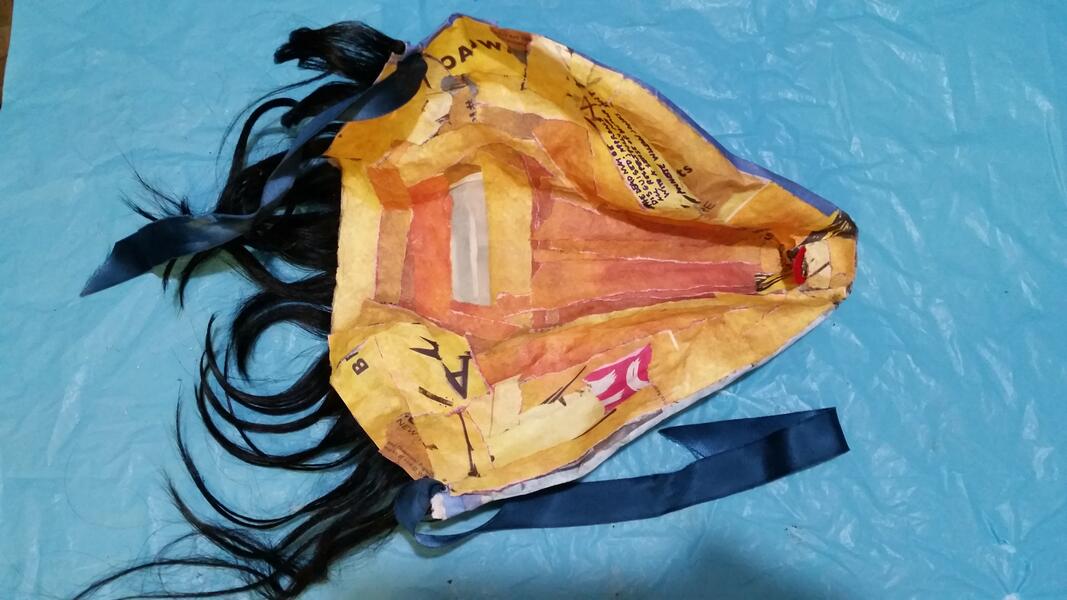 The Dead may be disguised; approach all with respect and a sense of humor
The Dead may be disguised; approach all with respect and a sense of humorReverse of the mask with the same name.
-
Calling a Golem, made from earth, to save this Earth and all living beings (front)
This mask is a representation of a "golem", a creature made from earth (like the biblical Adam) that, according to Jewish folklore and myth, can be brought to life by someone who has the knowledge to do so. Some versions of the legends say that, in order to activate the golem, the Hebrew for the word "truth" must be written on the forehead or on paper and inserted in the mouth. According to those legends, the golem is deactivated by removing one letter from the Hebrew, the "aleph", which changes the word from "truth" to "death".
We need Truth to activate a golem that will act to save Earth and all living beings, or Death will certainly follow.
Available for PurchaseContact by email to: [email protected]
-
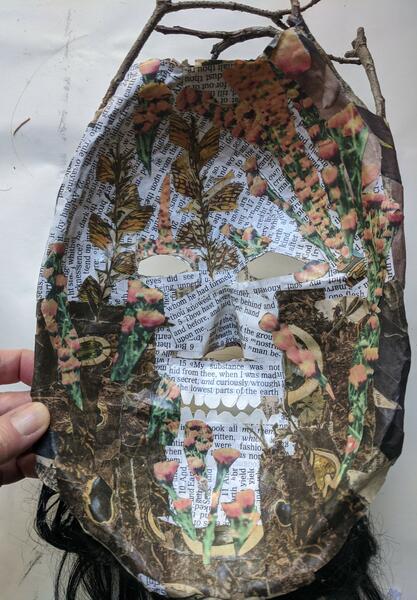 Calling a Golem made of earth, to save this Earth and all living beings- reverse view
Calling a Golem made of earth, to save this Earth and all living beings- reverse viewReverse view of the mask with the same name. This side is not visible when the mask is worn. The images include flowers growing out of dirt and copies of a page of the Book of Genesis that describes the creation of Adam from mud and earth.
Available for PurchaseContact by email to: [email protected]
-
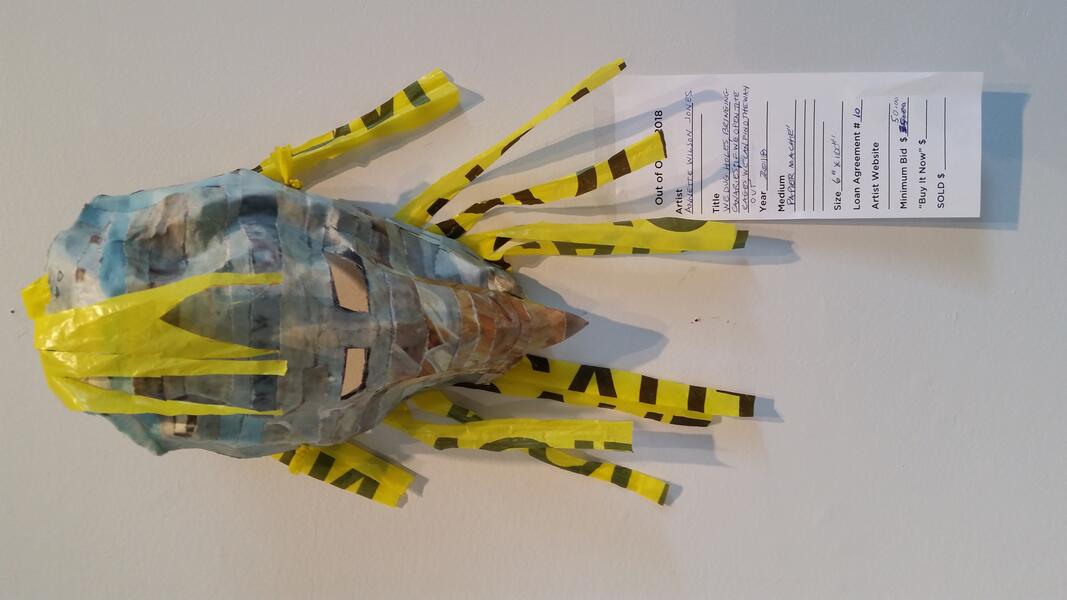 We dug holes, bringing canaries; if we open the cages, we can find the way out
We dug holes, bringing canaries; if we open the cages, we can find the way outThis mask was in the Maryland Art Place fundraiser show, "Out of Order", and was purchased before I had the opportunity to get a better photo of the front and a photo of the inside, or reverse, of the mask. I will ask the owner if they can take some photos for me.
Unnatural Disasters
A series of drawings, using graphite, pastel and colored pencils, depicting wild fires and other disasters that are becoming more frequent across the world as the climate continues to change.
-
 We will teach our children to fight the flames
We will teach our children to fight the flamesThis drawing, 17,5" x 23", was completed in 2019 shortly after the wild fire, known as the Camp Fire, that destroyed the town of Paradise, CA and over 150,000 acres in the surrounding area. That was 2018, many wild fires have followed with a staggering loss of life: human, animal and vegetable, including acres of mature trees and the habitat that they created.
The bottom quarter of this drawing is a graphite rubbing of the stump of a tree that was at least one hundred years old and had lived, and slowly died, across the street from a studio that I had. It was such a beautiful tree that I made as many rubbings of the trunk, as a memorial, as I could. The circle of bark can be seen at the top of that section.
Above the tree rubbing, after reports of the Camp Fire began to come out, I made rubbings of some of the textures that might be found in a house like one lost in that and other wild fires: a bathroom floor, the wood grain of a door and tongue and groove floor boards.
From the top of the page to the rubbing of the bathroom floor, I wrote words from some of the news reports of the fires and added text from reports of incidents of hatred: racist attacks, anti-semitic graffiti, homophobic slurs — sadly, those are just a few examples. Layered over the written text are graphite pencil drawings of bushes in the middle ground and trees along ridges in the background, conte crayon was added to indicate the red smoke that is in the wind. The fires are coming over the ridge, seemingly in the far distance, but threatening to grow in intensity.
The title refers also to fires of hatred, prejudice, ignorance and injustice, among others, that I feel we can and must teach our children to douse. This drawing was selected for inclusion in the 31st National Drawing and Print Exhibition and was chosen by the juror, Doreen Bolger, for a Purchase Prize Award. It is in the permanent collection of the Gormley Gallery at Notre Dame of Maryland University.
-
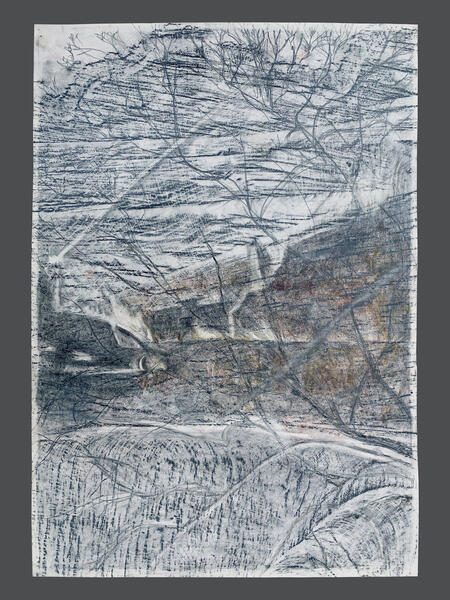 The neighborhood that is burning is our own
The neighborhood that is burning is our ownAnother drawing that was created in 2019, following the so-called Camp Fire that destroyed the town of Paradise in California. The image of a burning car is layer over the rubbing of the stump of an ancient tree and drawings of the shadows of tree branches were added.
-
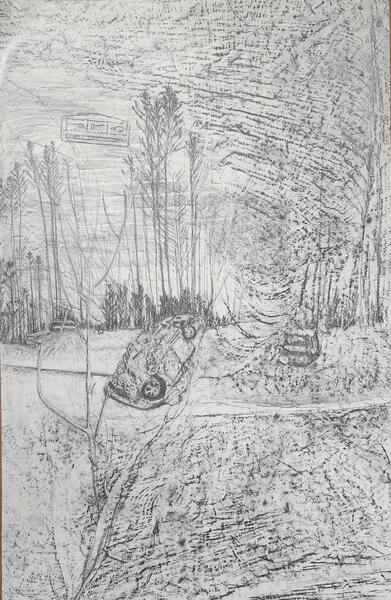 In memory of Paradise
In memory of ParadiseA large drawing based on news images from the 2018 Camp Fire that destroyed the town of Paradise and surrounding towns and areas. It includes a rubbing of a bathroom floor and a letterpress advertisement for tools as a memento of all of the homes and lives and livelihoods that were destroyed.
The first layer is a rubbing of the stump of a large tree, probably well over 100 years old, that stood across the street from my studio, at that time. The tree was slowly dying. When it was clearly dead, the city removed the large branches but some environmental activists threatened the workers and the tree was left to stand as a trunk from which all of the branches had been amputated. Finally, the city was able to come out and cut the rest of the tree down. It was a beautiful tree and I wanted to preserve its memory and the history contained within the rings.
Available for PurchaseContact by email
-
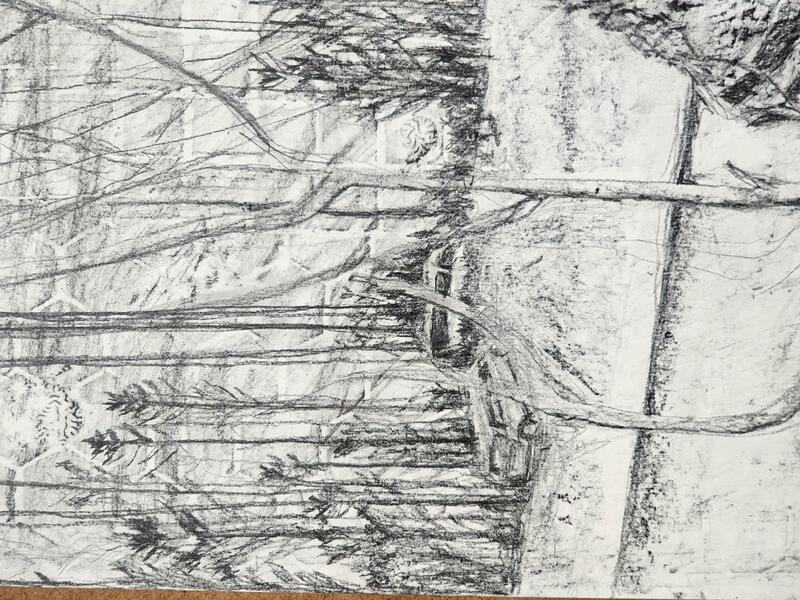 In memory of Paradise (detail)
In memory of Paradise (detail)Detail of "In memory of Paradise"
Available for Purchase -
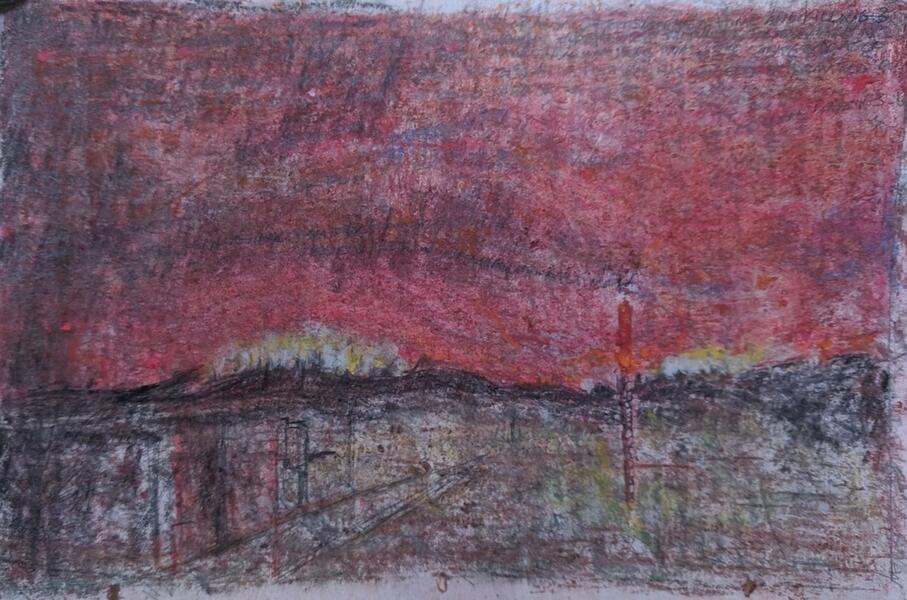 Our Home Is On Fire- forest fire, gun fire, wildfire
Our Home Is On Fire- forest fire, gun fire, wildfireSmall drawing over text based on images of wildfires.
Available for Purchase -
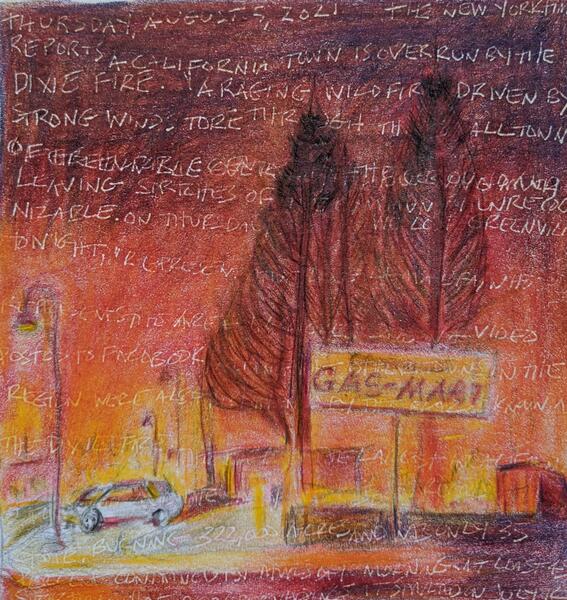 Dixie FireAvailable for Purchase
Dixie FireAvailable for Purchase -
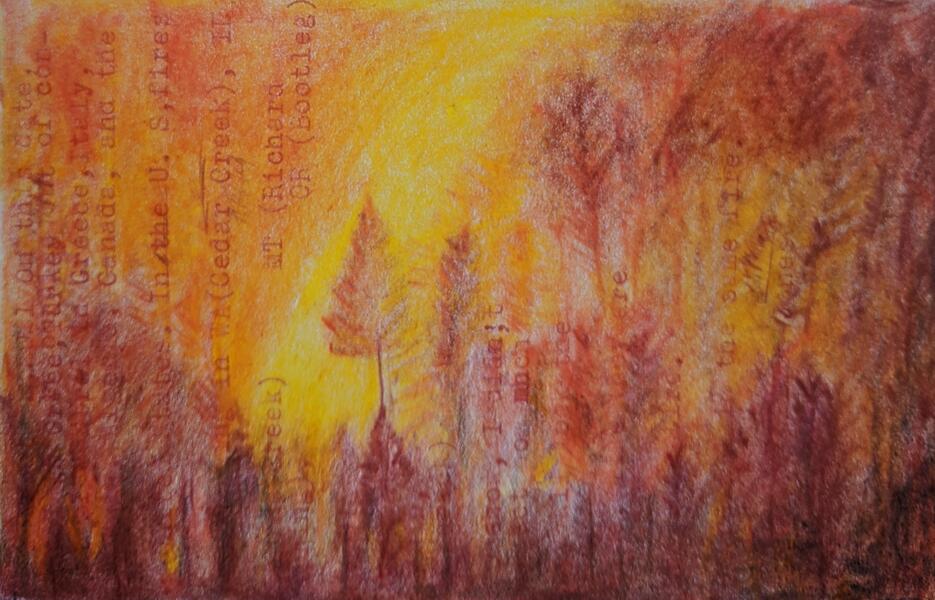 Second largest in state historyAvailable for Purchase
Second largest in state historyAvailable for Purchase -
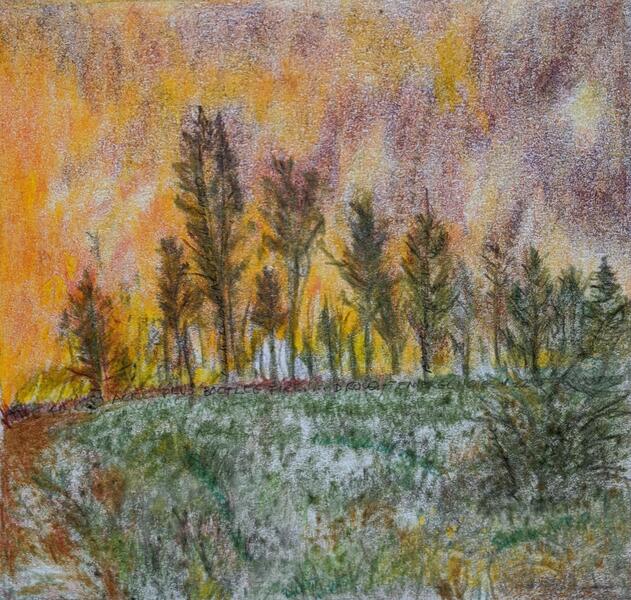 The West is on fire
The West is on fire -
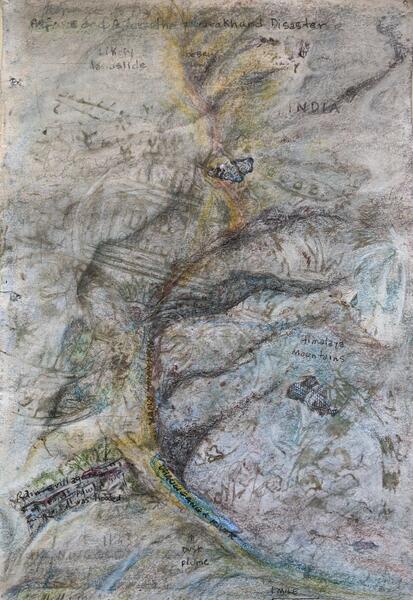 Uttarakhand Disaster 6-16-13
Uttarakhand Disaster 6-16-13Graphite, colored pencil, ink and collaged drawing over written text. Image is from a satellite view of the Himalayan mountain range at Uttarakhand India where there have been multiple devastating floods and landslides. This one refers to the flooding on June 16, 2013.
Available for Purchase
Hidden history
This project is one that is being developed and was instigated by my realization that my parents' marriage was illegal in the state in which I was raised. There is only one completed artwork in this series so far.
-
 Miscegenation - lessons
Miscegenation - lessonsThis 20" x 16" drawing uses a wintergreen oil process to transfer two photographs of: 1. my paternal grandmother in the Philippines, formally dressed in what looks like "traditional clothing" (top) and 2. my parents and paternal grandparents squeezed into a small couch in my grandparents' house in San Francisco, California. The photographs are layered over and around text that lists various "anti-miscegenation" laws, that existed in the U. S. until the 1967 Supreme Court ruling in Loving v. Virginia. This mixed media piece was selected for Interwoven Worlds, a show of work by Asian American Pacific Islander artists at Maryland Federation of the Arts.
Some states kept anti-miscegenation laws as part of their state constitution well after the Supreme Court decision that overturned the federal laws banning interracial marriage. South Carolina repealed its anti-miscegenation laws in 1998 and Alabama did not remove the law, or laws, banning such unions until 2000 — even then, 40.51% voted against the repeal.
My grandparents were married in the Philippines in 1903 and lived there with the oldest five of their children, until returning to the United States (they had moved to Canada and Washington State sometime after their marriage) in 1919, where my father was born in San Francisco. California continued to ban interracial relationships until 1948.
My parents were married in 1951, in Washington DC, where they both had moved for work. Their marriage would have been illegal in Virginia, where my siblings and I were raised and where my parents lived until their deaths (they had moved to VA shortly after they married) and in Maryland, where I now live. Maryland repealed its anti-miscegenation laws in 1967, as the Loving v Virginia case started, just prior to the Supreme Court ruling. In North Carolina, where my mother was born and raised, there were no explicit restrictions to marriages between Caucasians and those of other "races" — except, of course, Blacks and with the specific addition of "Croatian Indians". I doubt that there were very many Filipinos in North Carolina when these laws were written. Anti-miscegenation laws were removed from the state constitution following the Loving v Virginia ruling.
We were always told that my grandmother, that we, were Spanish. Genetic testing has shown otherwise. Now, knowing that my grandparents and my parents could have been dragged out of bed and jailed, I understand the lies and the need to hide our history.
Available for PurchaseContact by email to: [email protected]




































